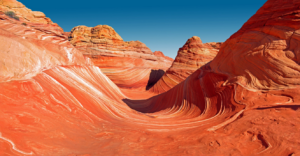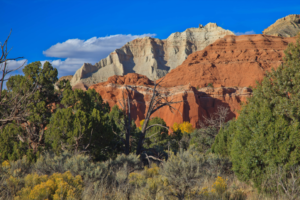Southwestern Utah features some of the most beautifully fantastic natural scenery in the country. Hidden arches, windswept sand dunes, brightly colored cliffs, and amazing rock formations are just a few of what you’ll uncover on a trip to Kanab.
When making a trip to southern Utah, visitors know they’re about to see some of the most beautifully fantastic natural scenery in the country. These unique landscapes provide a sense of must-see-to-believe magnetism. Hidden arches, windswept sand dunes, brightly colored cliffs, and amazing rock formations are just a few of the surreal landmarks you’ll uncover in Kane County, Utah.
The town of Kanab serves as an excellent base camp for your trip to explore the area’s most mesmerizing natural features. Here are seven of our favorites.
1. The Toadstools
Family-friendly, accessible, and awe-inspiring, The Toadstools are an excellent introduction to southern Utah’s otherworldly landscapes. From the trailhead just off US-89 about 45 miles east of Kanab, it’s an easy, 1.8-mile round-trip hike to explore this area, defined by the red and white striped hoodoos—the namesake Toadstools—that fill the valley. Eroded in their bizarre forms by wind, these fragile sandstone towers take on shapes reminiscent of mushrooms, gnomes, mythical creatures, and just about any other form gleaned by your imagination. The trail leads up a generally flat, sandy wash and gets full sun exposure, so plan accordingly during summer months.
2. Coral Pink Sand Dunes
The panorama of windswept sand hills at Coral Pink Sand Dunes State Park will have you wondering if you somehow left Utah and ended up in the Sahara. Situated about 20 miles west of Kanab, this park owes its dramatic landscape to high-velocity winds funneling into the valley and depositing rich-colored sand from eroded Navajo sandstone. Winds continually shape this wild landscape, causing sand dunes to shift as much as 50 feet per year.
ATV enthusiasts can have a field day exploring the park, as about 90 percent of the dunes are open for riding. Meanwhile, hiking on the soft dunes or even trying your hand at sandboarding (think snowboarding but without a parka!) make for other great ways to explore this unique setting.
3. The Wave

Cathy Palopoli
It’s hard to conjure up images of wild rock formations in the Southwest without the vibrant stripes of curved sandstone strata known as The Wave coming to mind. Situated along the Utah-Arizona state line in Vermilion Cliffs National Monument, the swirling layers of red, pink, gold, and white sandstone create a surrealistic pattern that entices hikers with a setting—and photo opportunities—unlike any other.
Hiking into The Wave (about a 5-mile round trip) requires a permit. Try the lottery system up to four months in advance or test your luck in snagging one of the coveted walk-in permits at the visitor center in Kanab.
4. Wahweap Hoodoos
After hiking three miles up the Wahweap Creek wash, the first throng of cream-colored sandstone pillars capped by purplish-red balanced rocks come into view. Nicknamed the “white ghosts,” these hoodoos catch your eye not only for their picturesque contrasting colors but also for their seemingly impossible height, with several reaching up to 50 feet tall.
Making the off-trail journey up the typically dry creek bed (pools and mud sloughs may appear after floods) to the three sets of hoodoos is worth it for an adventurous group. Exploring all three hoodoo zones and hiking back to the trailhead clocks in at about 9 miles round trip, with little or no shade coverage for most of the day. You’ll find the trailhead toward the southern end of Cottonwood Canyon Road, about 60 miles east of Kanab.
5. Coyote Buttes
Coyote Buttes comprise a sprawling landscape of sandstone knolls, ravines, and arches marked by their signature kaleidoscopic colors striped across the rocks. Typically split up into North and South Coyote Buttes, this broad region encompasses some of the most highly sought-after rock formations in southern Utah, such as The Wave, Melody Arch, Sand Cove, The Hooters, and Top Rock Arch.
Due to the fragile nature of this environment, day-use permits from the Bureau of Land Management are required and overnight camping is prohibited.
6. Kodachrome Basin

Murray Foubister
Renowned for its vast channels of multi-colored sandstone cliffs and buttes, Kodachrome Basin State Park offers plenty of land to explore. Five easy to moderate hiking trails crisscross the park, giving visitors access to the labyrinth of colorful valleys and rock formations. The Panorama Trail Loop and Angel’s Palace Trail offer an up-close-and-personal look at nature’s peculiarities.
Mountain biking, horseback riding, and camping are locals’ other favorite ways to experience Kodachrome Basin State Park.
7. Grosvenor Arch
A few miles from Kodachrome Basin State Park, this impressive double arch stands out as one of southern Utah’s most unique rock formations. Unlike many of the other sandstone arches in the state, Grosvenor Arch stretches high up onto the cliffside, creating a dramatic castle-like appearance. Another bonus is that reaching this stunning double arch doesn’t require miles of hiking through the sand. A short, handicap-accessible concrete path leads from the parking area to the base of the arch.
Written by Jenna Herzog for RootsRated in partnership with Kane County.